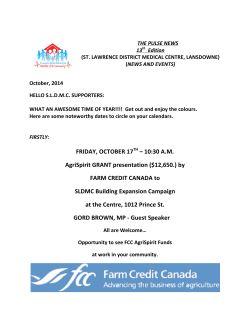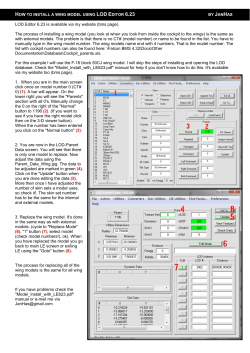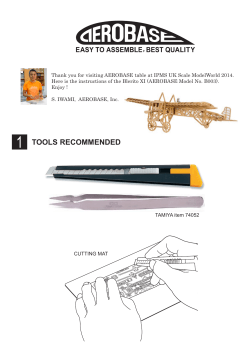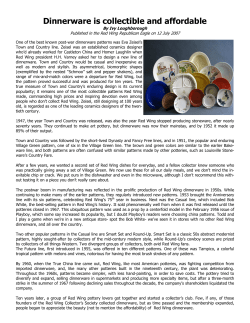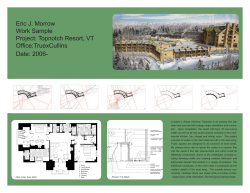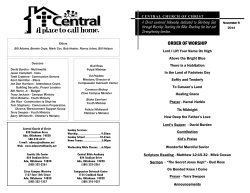
flight test Gradient Golden 4
flight test Gradient Golden 4 Colin Fargher reports THE CZECH AVIATION INDUSTRY REMAINS ONE OF THE WORLD’S LARGEST, AND ITS AERO-SPORT AND ULTRALIGHT MANUFACTURING AMONG THE MOST INNOVATIVE. IN FREE-FLYING THE LEADING EXAMPLE IS GRADIENT, who have a long tradition with their Golden series aimed squarely at the median of the EN/LTF B spectrum. All have been middle-ground performers with high passive safety. I’ve heard some describe the Golden 2 as being on the demanding side for low-airtimers, and others who found the Golden 3 to be a little too well-damped. But in all cases the wings show a very high quality of construction, materials and components. All are personally tested and refined by company manager Ondrej Dupal at their test site near Prague. 28 NOVEMBER 2014 www.skywingsmag.com Exclusivity: Everlast reinforced leading edge with mesh-covered and closed cells towards the tips Different weights of cloth are used throughout the wing to strengthen areas such as the leading and trailing edges. The sophisticated Double Diagonal internal structure, as used on Gradient’s higher-end wings, allows the use of the nowcommon reduced line threeriser system. Unsheathed lines are kept to those at the very top of the cascade, and all are protected where attached to the riser maillons by neat plastic blocks. Right: Three riser set-up: split As, maillons with with plastic insert protection, quality steel accelerator pulleys and press-stud retainers for the brake handles. Forward launch with tailwind: leading edge sits up, centre inflates first, then tips - easy-peasy! wing has no vices at all coming up overhead. I launched with a slight tailwind at the northerly Ballon d’Alsace take-off. The launch is shallow with a line of trees a couple hundred yards beyond, but such is the confidence one feels with the Golden 4 it wasn’t an issue at all. Reverse launching is also very simple, although there is often a need to damp the wing just a little with the brakes once overhead. I’d rate the wing as easy to launch and particularly good at forward launching. Photo: Colin Fargher Flying Launching Like all modern wings with reinforced leading-edge inserts, the initial launch phase is considerably easier than with older models whether forward or reverse launching. The one exception is the absolute necessity to hold the wing down with the C risers in strong or gusty conditions brakes are not enough. The My very first flight was at a small (300ft top-to-bottom) site in eastern France, just a slot cut in a small forested ridge we were using as the wind was too strong in the Vosges mountains. Pressure was high, with a marked inversion and a very strong wind gradient making the thermals tough to centre, increasingly cut up by the wind as you got a higher, and sink generally much stronger than lift. These were not ideal conditions for a first flight, but I was lucky to launch into probably the best cycle of the day and soon got up above the scratchy stuff at launch height. My first thought was just how quick and sharply the glider turned, instantly responding to weight shift. The brakes Ground handling is a pleasure The impression of quality is immediately evident from the silky inner bag the wing comes in and the exclusive material it is made from. Everlast, specially developed by Gradient and Porcher, is absolute top-ofthe-line sailcloth in terms of durability; it is, for the time being, available only to Photo: Anne-Catherine Fargher Photo: Anne-Catherine Fargher Photo: Anne-Catherine Fargher Photo: Anne-Catherine Fargher Gradient. A slight disadvantage is that colours are limited, but this seems a small price to pay for the advantages the material brings. The orange and blue colour scheme of the review glider, at least, is very pretty. Not many lines in this cascade! Note As are set back a bit from the leading edge required little pressure initially, but this built up gradually the harder the turn and the longer I held it in. This was all the more welcome as the other notable thing is the trim speed, which I found quite high compared to recent EN B wings I’ve flown. Quick, responsive controls and the ability to swap direction quickly was exactly what was needed to stay up. In fact if you’re brisk with the brakes the wing will bank up very steeply with little effort. I was flying the 26 model at 97kg, close to the top of its 85 100kg weight range. I should also point out that I was trying out a new Gin Genie Lite harness which was giving me a lot more feedback than my previous harness. It has a higher centre of gravity than I’ve been used to, and although essentially more unstable it was a gift in telling me all I needed to know about the air. Combined with the quick handling of the Golden 4 it was just superb, though my reactions definitely went up a notch - they needed to. Having nailed my local French club pilots to the ground with a record 20 minutes duration for the day, ten more than anyone else, I was impressed, but probably quite lucky too! As the wind died off we visited a much bigger site at Rupt-sur-Moselle. Here, in thick, dead air, was a chance to experiment with glide and duration. Though completely outgunned by local hotshot Thomas Gury and his super-slippery Icepeak 6, the Golden held its own with pretty much every other EN B or C wing on the hill, the main difference being its slightly higher speed than most Bs. However turning tightly to nail some weak lift was an error; my unthinking heavy-handedness resulting in a big increase in www.skywingsmag.com NOVEMBER 2014 29 Photo: Colin Fargher The Golden 4 responds well to weight shift sink rate as the wing banked up. Lesson No. 1: Use a bit of opposite brake to slow it down and turn flat and tight. On my first day at Annecy a reasonable northerly was still blowing down from the Jura making conditions rather uncomfortable. With the uneven ground humidity this made for spring-like conditions. On the Forclaz take-off at half three in the afternoon, cloudbase was still hiding the tops of les Dents de Lanfon. Again I was very lucky and immediately found a great climb, spiralling my way above a massive gaggle just to the right of launch. This time I remembered to adapt my technique and use plenty of outside brake to keep the turn as tight and flat as I could, and a few minutes later I was level with the clouds across the gap at les Dents. On glide it’s clearer than ever that the Golden 4 is on a par with just about everyone else and possibly a tad quicker than the majority. The glide, into quite a headwind, is a little rough in places. I’m on about one third bar and the wing jostles around in yaw a bit. Some small tip closures instantly open again, mere rustles in the turbulent air coming down the lake from the Jura. Eventually I and four others arrive at the furthest point of les Dents where at last the cloud has lifted. Here we face clearer air and are able to climb above the rocky teeth and cruise back towards Forclaz for another go. Some chance the glide over the lake to St Jorioz and the Roc des Bœufs but all are forced to land, something I would repeat myself the following day. On that occasion the Roc itself just refused to work and I was glad to have a quick and sharphandling machine to avoid the congestion as two dozen of us jostled for position in the poor conditions behind it. Eventually I had had enough and simply flew as far up the ridge as I could, out to the village of Puget, and landed. Happily, the Golden 4 will slow right down and landing in a tight spot is no drama. Given how fast the wing is trimmed I took the precaution of a wrap of brake, but I doubt that this is necessary. Brake pressure is very progressive and effective. If a full arm’s length is taken the wing will bank up steeply before settling a bit and tilting forwards towards the spiral position. All this is without too Photo: Anne-Catherine Fargher By late August, after eastern France’s worst summer on record, I’d had several unremarkable flights in les Vosges and an unsuccessful Alpine trip. Then, on the promise of the best forecast in two months, I shot down to the Alps again and spent several days flying around the wellknown petit tour du Lac d’Annecy. Many UK pilots will be familiar with this small triangle flight which has become almost a rite of passage for beginner XC pilots the world over. It has just about every element you might need to learn for any XC flight: various kinds of climbs, ridges and transitions and at least one big glide. And – the crucial element for me in this case – lots of other gliders to gauge the Golden 4 against. Given the recent weather it was no surprise to find Annecy very busy, but just how busy was bit of a shock. Even some of the local pros were pacing the Doussard landing field, staring in awe at the spectacle above, where over two hundred paragliders and hang gliders bejewelled the evening sky like giant stars. I have never witnessed such an awesome man-made spectacle in nearly 30 years of flying! 30 NOVEMBER 2014 www.skywingsmag.com much pressure, but before the wing enters the spiral pressure builds substantially and you’ll need some strength to hold it at full stretch for any length of time. The momentum is impressive though and the wing holds energy well given its lowly mid-B rating. Paramotorists may already see how these traits translate into a great wing for slalom racing. using the speed system when you’re already probably at max glide and catching gliders in front of you? Many pilots hardly use the bar at all. Being an exhangie, I use it a lot. The one small niggle of this setup is a slight tendency to overfly on strong reverse launches, but this is easily damped with a dab of brake. To me the Golden 4 is possibly this generation’s great all-rounder Stability The Golden 4 has a modest aspect ratio (5.3:1) and very good passive safety. In the windy conditions near les Dents I was perhaps more relaxed than I ought to have been; when I did let it all go with a poorly-timed exit from a gnarly thermal, I lost half the wing but the Golden 4 hardly batted an eyelid. A flutter and a thump as I dropped, with virtually no change of direction, and it whacked back out again within a second. Reassuring! Summary If you intend putting in lot of hours and/or you’re a wannabe Acro-Alex, it may well be worth considering a wing made from Everlast, and the Golden 4 might make a capable entrylevel acro wing. That’s not my thing and I have not tested it as such, but its aptitude is immediately evident from the trim speed and initial fast rolling response. Loads of fun! The advantage of a high trim speed, for the majority of club level and beginner XC pilots, is that it allows you to remain somewhat lazy on transitions between thermals. Why bother The trim speed also needs to be taken into consideration when thermalling. Initially I found myself banking up way too much when trying to tighten up in small cores; a degree of opposite brake is needed to slow the whole thing down and achieve a flatter, tight turn. To me the Golden 4 is possibly this generation’s great allrounder. You could use it for everyday coastal ridge-running, Alpine XCs, acro and paramotoring. The 24 and 26 sizes are also certificated to the French ‘ULM paramotor Class 1’ standard, although different multi-purpose risers are recommended for paramotor use. The Golden 4 has a very sensible aspect ratio and a reassuring level of passive safety, yet it’s fast, retains energy well and is very clean. It’s by no means demanding to fly, but you’ll certainly get much more out of it if you fly it actively. OK, there may be some Bs and low-end Cs with a bit more glide at speed or a smidgin better climb rate, but perhaps none are as versatile. It’s also built to last – loads of fun and loads of longevity means great value in my book. Specification Model 22 24 26 28 30 No of cells 51 51 51 51 51 Span (projected, m) 18.96 9.35 9.75 10.18 10.59 Area (flat, m2) 22.42 24.40 26.57 28.95 31.30 Aspect ratio 5.3:1 5.3:1 5.3:1 5.3:1 5.3:1 Maximum chord (m) 2.58 2.69 2.81 2.93 3.05 Line diameters (mm) 0.6, 0.7, 0.8, 1.0, 1.1, 1.3, 1.5, 1.8, 2.0 Glider weight (kg) 4.3 4.9 5.2 All-up weight range (kg) 62 - 77 75 - 90 85 - 100 95 - 115 100 - 130 EN/LTF certification B B B B Guarantee Price 5.6 B 5.9 1-year free repair service £2,995 £2,995 £2,995 £2,995 £2,995 UK importer: Snowdon Gliders, Yr Ynys, Mynydd Llandegai, Bangor, Gwynedd LL57 4BZ, tel: 01248 600330, e-mail: brad@snowdongliders.com, website: www.snowdongliders.co.uk.
© Copyright 2025
